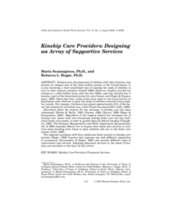ABSTRACT: Kinship care, the placement of children with their relatives, has become an integral part of the child welfare system in the United States. It is also becoming a more established way of meeting the needs of children in care in other western countries (Greeff, 1999). However, kinship care did not emerge as a child welfare issue until the late 1980s, and only recently has it become a part of the formalized system for out-of-home care (Hegar & Scannapieco, 1995). Since that time, many states have come to rely more heavily on placements with relatives to meet the needs of children removed from parental custody. For example, California has placed approximately 51% of the foster care population in kinship care, while Illinois has placed 55% (GAO, 1999).
Discussion about the reasons for the increases in kinship care has been widespread (Brooks & Barth, 1998; Gleeson, 1999; Harvey, 1999; Hegar & Scannapieco, 2000). Regardless of the impetus behind the increased use of kinship care, states must now incorporate kinship foster care into the traditional foster care system in order to qualify them for federal funding (O’Laughlin, 1998). The Personal Responsibility and Work Opportunity Reconciliation Act of 1996 amended federal law to require that states give priority to relatives when deciding with whom to place children who are in the foster care system (GAO, 1999).
The apparent paradigm shift from traditional foster parents to kinship care parents (Hegar, 1999) requires that agencies use both different approaches to assessment (Scannapieco & Hegar, 1996) and provide different types of intervention and services. Adapting placement services to the needs of kinship care providers is the focus of this article.

